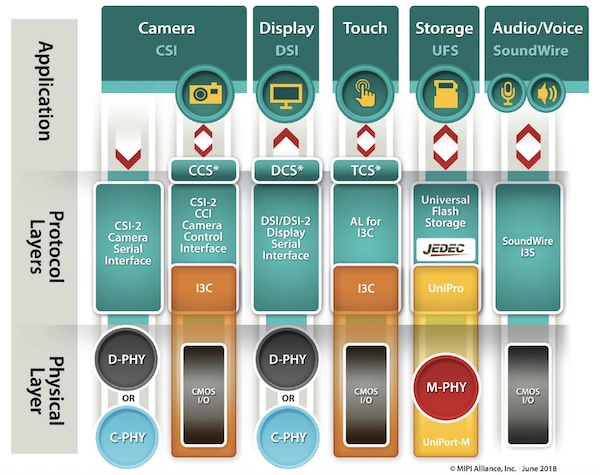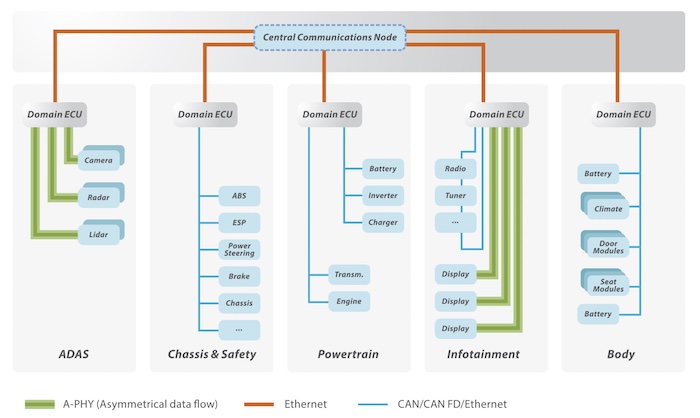Standards are critical to market competitiveness, quality, interoperability, and, ultimately, provide access to technology that would otherwise be proprietary. Open technology standards allow engineers to compete with their design skills focused on cost, application innovation, and economies of scale for a worldwide market.
A new automotive standard, the IEEE 2977-2021, was approved and published last month.

A high-level overview of creating an IEEE standard. Image used courtesy of IEEE Innovation at Work
It is an IEEE adopted standard of the MIPI Alliance specification for the A-PHY interface. MIPI first released MIPI A-PHY v1.0 in June 2020.
Over the past year, the MIPI A-PHY v1.0 would go through internal member approval and see MIPI develop a memorandum of understanding with the IEEE association, which led directly to the release of IEEE 2977-2021.
What is the MIPI Alliance, and why is the A-PHY interface a potential game-changer that the IEEE just had to adopt? What came before the A-PHY specification? These are the questions today's article will seek to address.
The Past: Physical Interfaces for ADAS
The MIPI Alliance is focused on hardware interfaces for mobile and mobile-influenced applications. Its venerated standards, D-PHY/C-PHY, are severely limited in range and, as such, require external hardware chips to facilitate long-reach SerDes. Thus, to overcome this expensive and complex architecture, it created the A-PHY interface.

Existing long-reach SerDes use bridge interfaces. Image used courtesy of the MIPI Alliance
The A-PHY is referred to as a long-reach SerDes physical layer interface with distances up to 15 m compared with D-PHY and C-PHY, which is 15 cm. This specification eliminates the need for additional PHY bridges to accommodate long-reach SerDes for CSI-2 (MIPI camera protocols).

Simplified long-reach SerDes with A-PHY. Image used courtesy of the MIPI Alliance
Reducing the external hardware between the sensor and electronic control unit (ECU) is of the utmost importance to improving quality and reducing cost and complexity, but what specific performance metrics can engineers expect from the A-PHY hardware?
The Present: An Overview for the MIPI A-PHY Specification
The basic specifications for the A-PHY include one or two lanes up to 16 Gbps with an ultralow packet error rate of 10-19. The primary benefit of this protocol is the ability to travel up to 15 m, combining high-speed data, control, and power over a single cable.
Also, the MIPI A-PHY protocol is versatile and can be used to communicate with advanced driver assistance systems (ADAS), human-machine interfaces (HMI), and infotainment hardware.
The protocol is designed to natively interface with other MIPI protocols, like the MIPI camera serial interface, which enables the simplified design architecture.
Taking a higher-level point of view, how does the MIPI A-PHY fit into a holistic automotive system?
The Future of Automotive System Engineering in 2021
Aside from being a proven protocol in the mobile industry, MIPI is said to also deliver several other key system-level benefits with A-PHY:
- Optimized against cost considerations, specifically concerning cabling, weight, and the asymmetric design of the protocol,
- Enabled as a hardware-only protocol, without the need for software configuration, and finally,
- The system is said to have high EMC immunity, which is a critical system-level requirement for interoperability.
Additionally, MIPI A-PHY runs as part of a concurrent system of data transfer protocols, each suited to their best applications.

System-level block diagram for a modern digital vehicle. Image used courtesy of the MIPI Alliance
Playing nice with other protocols, along with the unique solution presented by the A-PHY specification, were the likely reasons that the IEEE endorsed this standard. But, how does the IEEE benefit the MIPI Alliance?
What IEEE Adoption Means to MIPI A-PHY v1.0
The IEEE-2977-2021 brings a level of exposure to the A-PHY ecosystem that would have been lacking otherwise. Although the MIPI Alliance has been a member of the IEEE since 2003, this is the first interface specification for external adoption.
The process for adoption began in October 2020, shortly after being internally ratified within the MIPI Alliance membership, and received IEEE board approval on June 16, 2021.
Reviewing the project authorization request (PAR) for IEEE-2977-2021 yields interesting details about the features of the A-PHY specification, including the concept of protocol adaptation layers that can convert A-PHY to other protocols, including VESA's DisplayPort. Beyond that, the PAR describes why the project is unique and how it solves an industry need (the removal of proprietary interfaces in automotive design).
Have you ever worked in standards development? What engineering goal drove the development of that standard? Let us know in the comments below.
